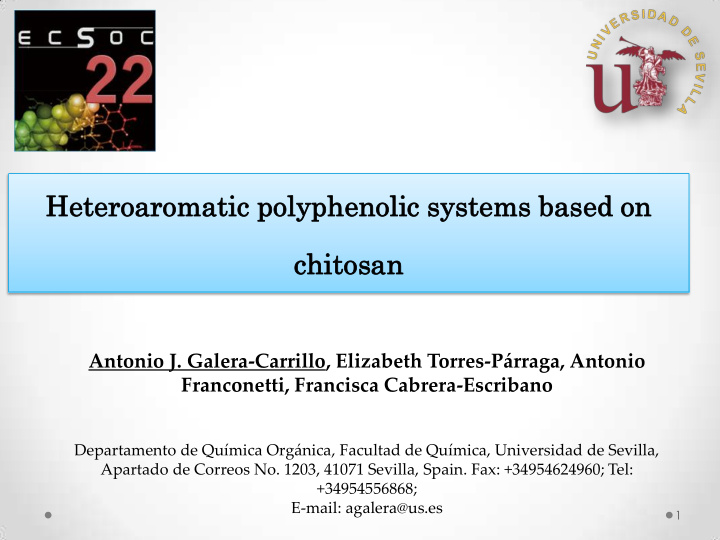



Heter eroa oaro romati matic poly lyphen henol olic ic syste tems s based d on n ch chit itosa san Antonio J. Galera-Carrillo, Elizabeth Torres-Párraga, Antonio Franconetti, Francisca Cabrera-Escribano Departamento de Química Orgánica, Facultad de Química, Universidad de Sevilla, Apartado de Correos No. 1203, 41071 Sevilla, Spain. Fax: +34954624960; Tel: +34954556868; E-mail: agalera@us.es 1
Aims Polyphenolic compounds Chitosan POLYPHENOLIC SYSTEMS BASED ON CHITOSAN Compounds with expected … • High biological activity • High photophysical properties • Multivalent presentation of polpyphenolic systems through chitosan 2
Synthesis of polyhydroxysubstituted heteroaromatic complexes Expected Methodology used was previously optimized for this laboratory to obtain p -substituted pyrylium salts First aim was the synthesis of polyphenolic pyryliums salts, but the presence of any other kind of compounds was detected in some cases by RMN and HRMS: 3-desoxyanthocyanins and flavonoids 1) Pyrylium salts 3 Franconetti, A., Contreras-Bernal, L., Jatunov, S., Gómez-Guillén, M., Angulo, M., Prado-Gotor, R., Cabrera-Escribano, F., Physical Chemistry Chemical Physics 2014 , 16 (34), 18442-18453
Synthesis of polyhydroxysubstituted heteroaromatic complexes 2) 3-desoxyanthocyanins Intramolecular reaction occurs due to the presence of an hydroxy group in ortho - possition of benzaldehyde 4
Synthesis of polyhydroxysubstituted heteroaromatic complexes 3) Flavonoids Intramolecular reaction occurs due to the presence of an hydroxy group in ortho - possition of acetophenone 5
Chitosan Cromylium and Pyrylium derivates 60 ºC 60 ºC Pyridium Quinolinium 4. Franconetti, A., Contreras-Bernal, L., Prado-Gotor, R., Cabrera-Escribano, F. RSC Advances , 2015 5 (91), 74274-74283. 6
Degree of Substitution (DS) 𝐽 𝐼−𝐵𝑠𝑝𝑛𝑏𝑢𝑗𝑑 𝑜 𝐵𝑠𝑝𝑛𝑏𝑢𝑗𝑑 𝐸𝑇 (%) = DS (%) (Example) = 10,3 % 𝐽 𝐼2−𝐼6 6 H3,H4,H5,H6 y H6´ H2 NCOCH 3 H1 H-Aromáticos 1 H-RMN (500 MHz) of chitosan derivate solved in CD 3 COOD/D 2 O : 7
Conclusion and future work Reaction of polyhydroxysubstituted acetophenones with substituted benzaldehydes not only lead to pyrylium salts as expected, but 3- desoxyanthocyanins and flavonoids are also obtained. Benzaldehydes with an hydroxy group in ortho possition lead to 3- desoxhyanthocyanins while acetophenones with an hydroxy group in same situation originate flavonoids. On the other hand, when there is no exist ortho hydroxy group neither in benzaldehyde nor acetophenone, chalcone or pyrylium salt is obtained. New quaternized derivatives of chitosan have been synthesized, specifically pyrydinium and quinolinium salts derived from chitosan by reaction of the biopolymer with the corresponding salts of pyrylium and cromylium, respectively. Photophysical properties and antioxidant capacity of these new compounds must be studied. 8
Recommend
More recommend